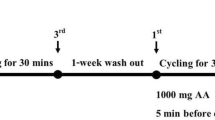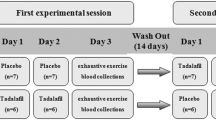Abstract
The purpose of this study was to compare the pro-antioxidant status in healthy men exposed to muscle-damaging resistance exercise, and to investigate the practical application of Loverro’s coefficient (P/A ratio) to evaluate the presence of oxidative stress. Twenty-eight healthy men were assigned to two groups performed multi-joint (M) or single-joint (S) resistance exercise. The activities of superoxide dismutase (SOD), glutathione peroxidase (GPx) and catalase (CAT) as well as the concentration of lipid peroxidation products (TBARS) in blood were evaluated. The P/A ratio was calculated from the mean values of erythrocyte TBARS, SOD, CAT and GPx. Creatine kinase (CK) activity was used as a marker of muscle damage. The applied resistance exercises triggered off the changes in pro-antioxidant ratio towards peroxidation which was proved by significant increase in erythrocyte TBARS concentration in M (+25%) and S (+27%) groups. Plasma TBARS increased only after multi-joint resistance exercise and correlated with erythrocyte P/A ratio (r=0.536, P<0.01). The multi-joint exercise caused decrease in SOD activity by 28% whereas the single-joint resistance exercise elevated enzyme activity by 20%. Activities of the other antioxidant enzymes changed simultaneously i.e. CAT activity increased by 14%–16% immediately after exercise, and GPx activity declined by 18%–34% during recovery in M and S groups. Even though, all erythrocyte parameters significantly changed following multi-joint and single-joint resistance exercises, the assessment of proantioxidant ratio showed the considerable increase in P/A only in M group. In summary, an analysis of pro- and antioxidant parameters showed significant changes in response to muscle-damaging exercise and demonstrated the practical application of P/A ratio to evaluate the risk of oxidative stress in athletes.
Resumen
Se estudia en el presente trabajo el estado oxidativo en hombres sanos sometidos a ejercicio contra resistencia con lesión muscular y la aplicación práctica del coeficiente de Loverro (relación P/A) para evaluar la existencia de estrés oxidativo. El estudio se llevó a cabo con 28 hombres sanos divididos en 2 grupos según realizaran ejercicio contra resistencia multiarticular (grupo M) o de articulación simple (grupo S). Se determinaron en los eritrocitos las actividades de superóxido dismutasa (SOD), glutatión peroxidasa (GPx) y catalasa (CAT) y la concentración de productos de peroxidación lipídica (TBARS). La relación de prooxidantes/antioxidantes (relación P/A) se calculó a partir de los valores medios de TBARS/SOD, CAT y GPx. La actividad creatina quinasa se utilizó como marcador de lesión muscular. El ejercicio contra resistencia dió lugar a incremento de la concentración de TBARS en eritrocitos tanto en el grupo M (+25%) como en el S (+27%). En plasma, el nivel de TBARS aumentó sólo en el grupo M, en correlación con la relación P/A (r=0.536; P<0.01). En el grupo M, la actividad SOD disminuyó un 28%, aumentando un 20% en el grupo S. La actividad de los otros enzimas antioxidantes se modificó paralelamente en los dos grupos (la de CAT, aumentó immediatamente después del ejercicio y la de GPx disminuyó durante la recuperación). En conjunto, los resultados indican cambios significativos en los parámetros pro y antioxidantes en respuesta al ejercicio con lesión muscular y demuestran la aplicación práctica de la relación P/A para evaluar el riesgo de estrés oxidative en los atletas.
Similar content being viewed by others
References
Aebi, H., Catalase (1991): Catalase. In “Techniques in Free Radical Research” (Rice-Evans C.A., Diplock A.T. and Symons M.C.R., Eds.), Elsevier, Amsterdam, London, New York, Tokyo, pp. 199–201.
Buege, J., Aust, S.D. (1991): The thiobarbituric acid assay. In “Techniques in Free Radical Research” (Rice-Evans C.A., Diplock A.T. and Symons M.C.R., Eds.), Elsevier, Amsterdam, London, New York, Tokyo, pp. 147–148.
Drabkin, D.L. (1946): Spectrophotometric studies. XIV. The crystallographic and optical properties of the hemoglobin of man in comparison with those of other species. J Biol Chem, 164, 703–723.
Elosua, R., Molina, L., Fito, M., Arquer, A., Sanches-Quesada, J.L., Covas M. J., Ordonez-Lianos, J. Marrugat, J. (2003): Response of oxidative stress biomarkers to a 16-week aerobic physical activity program and to acute physical activity in healthy young men and women. Atherosclerosis, 167, 327–334.
Groussard, C., Rannon-Bekono, F., Machefer, G., chevanne, M., Vincent, S., Sergent, O., Cillard, J. Grates-Delamarche, A. (2003): Physical fitness and plasma non-enzymatic antioxidant status at rest and after a Wingate test. Eur J Appl Physiol, 89, 14–20.
Hübner-Wozniak, E., Panczenko-Kresowska, B., Lerczak, K., Posnik, J. (1994): Effects of graded treadmill exercise on the activity of blood antioxidant enzymes, lipid peroxides and nonenzymatic antioxidants in long-distance skiers. Biol Sport, 11, 217–226.
Jammes, Y., Steinberg, J.G., Bregeon, F., Delliaux, S. (2004): The oxidative stress in response to routine incremental cycling exercise in healthy sedentary subjects. Resp Physiol Neurobiol, 144, 81–90.
Jenkins, R.R., Krause, K., Schofield, L.S. (1993): Influence of exercise on learance of oxidant stress products and loosely bound iron. Med Sci Sports Exerc, 25, 213–217.
Ji, L.L. (1999): Antioxidants and oxidative stress in exercise. PSEBM, 222, 283–292.
Klapcinska, B., Kempa, K., Mossakowska,M., Derejczyk, J. (2006): Blood antioxidant potential as a predictor of successful aging? Results of a study on polish centenarians. International Congress Medicina Sportiva Krakow. Med Sport, 10, 47 (abstract).
Knez, W.L., Jenkins, D.G., Coombes, J.S. (2007): Oxidative stress in half and full Ironman Triath-letes. Med Sci Sports Exerc, 39, 283–288.
Leaf, D.A., Kleinman, M.T., Hamilton, M., Barstow, T.J. (1997): The effect of exercise intensity on lipid peroxidation. Med Sci Sports Exerc, 29, 1036–1039.
Loverro, G., Greco, P., Capusano, F., Carone, G., Selvaggi, L. (1996): Lipoperoxidation and antioxidant enzymes activity in pregnancy complicated with hypertension. Eur. J Obstet Gynecol Reprod Biol, 70, 123–127.
Marzatico, F., Pansarasa, O., Bertorelli, L., Somenzini, L., Della-Valle, G. (1997): Blood free radical antioxidant enzymes and lipid peroxides following long-distance and lactacidemic performances in highly trained aerobic and spring athletes. J Sports Med Phys Fitness, 37, 235–239.
Paglia, D.E., Valentine, W.N. (1967): Studies on the quantitative characterization of erythrocyte glutathione peroxidase. J Lab Clin Med, 70, 158–169.
Sen, C.K. (1995): Oxidants and antioxidants in exercise. J Appl Physiol, 79, 675–686.
Sureda, A., Tauler, P., Aguilo, A., Cases, N., Fuentespina, E., Cordova, A., Tur, J.A., Pons, A. (2005): Relation between oxidative stress markers and antioxidant endogenous defences during exhaustive exercise. Free Radic Res, 39, 1317–1324.
Szygula, Z. (1990): Erythrocytic system under the influence of physical exercise and training. Sports Medicine, 10, 181–197.
Tauler, P., Gimeno, I., Aguilo, A., Guix, M.P., Pons, A. (1999): Regulation of erythrocyte antioxidant enzyme activities in athletes during competition and short—term recovery. Eur J Physiol, 438, 782–787.
Tauler, P., Aguilo, A., Gimeno, I., Fuentespina, E., Tur, J. A., Pons, A. (2006): Response of blood cell antioxidant enzyme defences to antioxidant diet supplementation and to intense exercise. Eur J Nutr, 45, 187–195.
Vesovic, D., Borjanovic, S., Markovic, S., Vidakovic, A. (2002): Strenuous exercise and action of antioxidant enzymes. Med Lav, 93, 540–550.
Zembron-Lacny, A., Szyszka, K., Sobanska, B., Pakula, R. (2006): Prooxidant-antioxidant equilibrium in blood of rowers; effect of a single dose of vitamin E. J Sports Med Phys Fit, 46, 257–264.
Zembron-Lacny, A., Szyszka, K., Szygula, Z. (2007): Effect of cysteine derivatives administration in healthy men exposed to intense resistance exercise by evaluation of pro-antioxidant ratio. J Physiol Sci, 57, 343–348.
Author information
Authors and Affiliations
Corresponding author
Rights and permissions
About this article
Cite this article
Zembron-Lacny, A., Ostapiuk, J., Slowinska-Lisowska, M. et al. Pro-antioxidant ratio in healthy men exposed to muscle-damaging resistance exercise. J. Physiol. Biochem. 64, 27–35 (2008). https://doi.org/10.1007/BF03168232
Received:
Issue Date:
DOI: https://doi.org/10.1007/BF03168232




